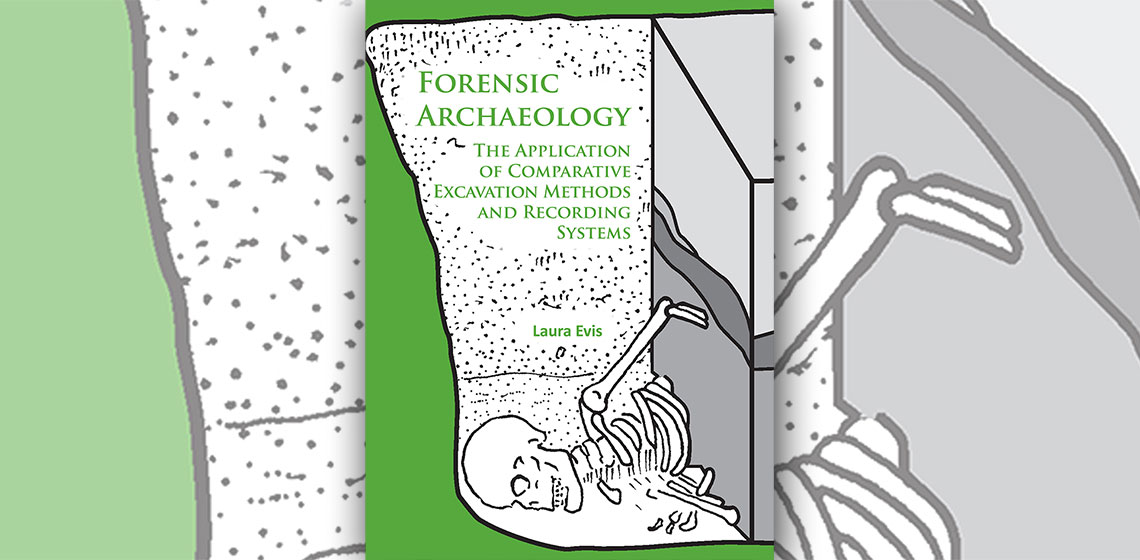
This book is a rewrite of Evis’ PhD thesis compiled between October 2010 and March 2014 at Bournemouth University (University of Exeter 2017). The study was an evaluation of the archaeological excavation methods and recording systems used in the United Kingdom, Ireland, Australasia and North America. The evaluation specifically targeted their ability to satisfy admissibility tests introduced by the Law Commission and international bodies of law, and their ability to provide a high calibre of forensic evidence. The book is divided into eight chapters, in addition to four appendices, with figures and images throughout.
The introduction sets forth the premise and aims of the research (described above). It also details the objectives hoped to be achieved during the research process:
1. to review and compare archaeological manuals and guidelines;
2. to review the origins, development and current usage of such literature;
3. interview archaeologists to determine how, why, and when they use a given method;
4. to create and carry out a controlled experiment to test the various methods; and
5. examine the effects of methodology and experience have on the quality of the excavation, quantity of artefacts recovered, and consistency of interpretation.
Chapter 2 details the excavation techniques, including the way each is performed and a brief history of how/why the technique was developed. These techniques include: stratigraphic (4), demirant or quadrant (7), and arbitrary techniques (10). The remainder of Chapter 2 considers how these techniques have been, thus far, adapted to be used in forensic environments.
Chapter 3 outlines the methods used to evaluate the archaeological techniques within the confines of Evis’ research. This firstly consisted of tracing, ultimately 153, user manuals/guidelines for ‘evidence’ collection from archaeological companies and organisations across the geographic boundaries set forth in Chapter 1 (30). These manuals were then reviewed, analysed and compared. Secondly, the archaeological methods were assessed, using a standardised grave simulation. This tested the excavation and recording methods, as well as the general interpretation of material evidence and understanding of stratigraphic relationships.
Chapter 4 provided details of the manual analyses. Results included the type of organisation producing a manual, whether commercial, research, or governmental, and the correlation between excavation and organisation type. Evis does make limited suggestions as to why different geographic areas or organisation types use different methods. However, the discussion is limited to traditional archaeology. There is no section discussing the manuals as they relate to the realm of forensics.
Chapter 5 is a summary of the interviews conducted with the individual archaeologists. Here, the overriding theme is that recording and excavation methods tend to change in accordance with the circumstances surrounding the excavation. Reasons were ranked from most important to least important (71-75), beginning with:
- the aims and objectives;
- type of site;
- field expertise;
- communication with other archaeologists;
- previous archaeological training;
- governmental requirements;
- literary sources; and lastly
- the recording system.
This is followed by various justifications provided by the archaeologists for using the stratigraphic, demirant, quadrant, or arbitrary excavation techniques, in addition to reasons for using a particular recording method. These justifications generally amounted to comfort, preference and training. Again, no discussion was given with reference to the practice of forensics.
Chapter 6 details the 50 standardised excavations conducted by 40 archaeologists and 10 laymen used as controls (37). According to Evis, results suggest that the Quadrant Excavation method and Standard Context Recording system was the most consistent, efficient, and reliable approach to use in the recovery of a ‘clandestine’ burial (212). This is closely followed by the Demirant method and then the Stratigraphic Method; both in combination with the Single Context Recording system. The author also states that archaeological experience seems to have little impact on the effectiveness of these methods (205-6).
Chapter 7 is entitled ‘Conclusion’ and summarises the previous chapters. This conclusion is followed by a brief Chapter 8, which provides recommendations for using the current methods, along with a recommendation for an internationally recognised committee to develop protocols for forensic use (214).
As this is a relatively new line of study, there are some logistical problems which may be impacting the results. Firstly, archaeological experience was found to have little bearing upon the recovery of evidence from the grave simulation. However, Evis lists the archaeological experience of each participant as number of years and whether that experience is commercial or academic (236). The author does not include in what form the archaeological experience is; whether that experience is in landscapes, architecture, cemeteries, microfauna and so on, whether urban or rural, or if the participant has any forensic training. Secondly, the author records whether the participant sieved the spoil. However, the author does not indicate what type of sieve is used; wet or dry, what grade, and so forth (see Chapter 6). Both sources of information may impact the results of this study and may be worth further consideration. In addition, the evidence and stratigraphic layers were recorded as ‘found’ or ‘not found’. No allowances were made for size, colour, texture or material. Taking such aspects into account during analyses may alter the results of the testing. Nevertheless, Evis’ work is an important first step in the standardisation of forensic archaeology.
Book information:
EVIS L. (2016). Forensic Archaeology: The Application of Comparative Excavation Methods and Recording Systems Oxford, Archaeopress. viii+240 pages; illustrated in black & white throughout. Printed ISBN 9781784914844 (£38).
E-publication ISBN 9781784914851 (£19).